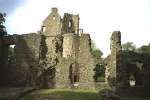Kings of Picts used the resource centred on what is now called Rhynie in Aberdeenshire and much gold used for the crown jewels, prior to Robert Bruce’s takeover, was Aberdeenshire gold.
Pearls were also sourced in Aberdeenshire from the River Ythan and the pearl in the Crown of Scotland (now in disuse) is from the Ythan (Buchan, outlet into North Sea north of Dee and Don). Kings prior to the Scots takeover AD843 had landholdings in Cé (present Aberdeenshire) and it remained one of the richest areas for royal hunting (Royal Forests of Derley, Deer, Gight, Garioch, Insch, Forgue, Cabrach, Letter (Ladder), Mar, Stocket and Udny & Dudwick); farming and artisan crafts.The most influential ‘Celtic’ earl before Robert I Bruce’s reshuffle was John Comyn Earl of Buchan, descended through marriage from Marjorie, last of the Pictish princesses of Derlei (Derley, Fyvie); and coincidentally nephew of John Balliol who was himself descended from the Pictish royal line through his mother Devorguila. When Bruce murdered John Comyn in Dunfermline in 1306 in order to secure Comyn lands and thereby claim Scots throne through wealth, Comyns rose as a tribe to fight back.

Ruinous Huntly Castle, Aberdeenshire whose heraldic doorway was personally hacked by monarch James VI
Comyns’ storehouse of gold (from Rhynie) was plundered and used to buy Bruce the kingdom of Scots. Bannockburn was merely a ‘follow-up’ battle in what is now colloquially called the ‘Central Belt’ to ensure Scotland’s independence from England. It was the nail in the coffin of the Buchan Pictish line.
Aberdeenshire’s grand houses from that time were no longer in use by the monarch, except in nominal annual visits or ‘progresses’ by the Royal House.
Fyvie and other castle strongholds of importance for previous royal patronage became private houses of the nobility which supported Bruce and his descendants. Rhynie gold and Ythan pearls descended into oblivion.
copyright 2009 Devorguila


December 8, 2010 at 7:28 pm
Fantastic! Thanks for the lesson. I’am a ‘Cummins’ (Comyns), and only in the last week have through internet searching of my surname come to find all this Amazing History. I came by this at first:
http://www.comins.org/cummingsname.htm
Thanks
Aled Cummins {ArthManual)
January 20, 2011 at 10:44 pm
What a great lineage to be part of – nothing stronger has survived the transition from Pict to ‘Scots’. You must be proud. Forgive my tardy reply – festive period with family. I am guessing (your Christian name) that you have another fiercely strong ancient Brittonic root in your family line – the Picts & ancient Welsh were allies… 🙂
January 22, 2011 at 1:40 pm
Hello! Thanks for the reply, hope you had a great Christmas. My Christian name (Aled) is Welsh & my family are Welsh speakers. I traced back that my Grandfather’s Grandfather had come to Wales from Cornwal looking for work in 1860 and it was one of his five siblings who learnt to speak Welsh during a time when England had put a ban on the Welsh language being spoken & taught in school’s. So unfortunately no ancient Welsh roots.
Oooops! Hope i havent bored you with that information. Cheers 🙂
February 10, 2011 at 11:54 am
oh well don’t despir – the Cornish are an even more fiercely Brittonic ancient race
February 29, 2020 at 1:42 am
Reblogged this on Youngblood Blog and commented:
After the 1308 Herschip o’Buchan by Robert Bruce, whose firebrands scorched their route from ‘Burgh to Broch'(Inverurie to Fraserburgh), Aberdonians recall Caledonian forest trees burned for fifty years. Centers of power shifted south, taking with them Rhynie gold and Ythan pearls—both still shine in Royal Regalia of Scotland, alongside stylized Pictish beast-dolphin in Edinburgh Castle vault. Nevertheless, Scots Pine replanting has begun!